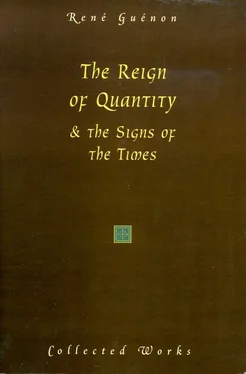Quality and quantity are fairly generally regarded as complementary terms, although the profound reason for their complementarism is often far from being understood, this reason lying in the ‘polar’ correspondence referred to toward the end of the introduction to this book. This, the first of all cosmic dualities, is a starting-point, for it is situated at the very principle of existence or of universal manifestation, and without it no manifestation would be possible in any mode whatsoever: it is the duality of Purusha and Prakriti according to the Hindu doctrine, or to use another terminology, that of ‘essence’ and ‘substance’. Its two terms must be envisaged as universal principles, and as being the two poles of all manifestation; but, at another level, or rather at a number of different levels (for there are many levels, corresponding to the more or less particularized domains that can be envisaged in the interior of universal manifestation), these two terms can also be used analogically and in a relative sense to designate that which corresponds to the two principles, or most directly represents them with reference to a particular more or less limited mode of manifestation. Thus it is that essence and substance can be spoken of in relation either to a world, that is to say to a state of existence determined by certain special conditions, or in relation to a being considered as a separate entity, or even to each of the states of that being, that is to say, to its manifestation in each of the degrees of existence; in this last case, there is naturally a correspondence between what essence and substance represent in the microcosm and what they represent, considered from a macrocosmic point of view, in the world in which the manifestation of the being is situated; in other words, they are then only particularizations of the relative principles that are the determinations of universal essence and substance in relation to the conditions of the world in question.
Understood in this relative sense, and especially with reference to particular beings, essence and substance are in effect the same as the ‘form’ and ‘matter’ of the scholastic philosophers; but it is better to avoid the use of these latter terms because, doubtless owing to an imperfection of the Latin language in this connection, they only convey rather inaccurately the ideas they ought to express, [1] These words translate in a rather unsatisfactory way the Greek terms εἶδος and ὕλη employed in the same sense by Aristotle. These terms will be referred to again later.
and also because they have lately become even more equivocal by reason of the quite different meaning commonly assigned to them in current speech. However that may be, to say that every manifested being is a composite of ‘form’ and ‘matter’ amounts to saying that its existence necessarily proceeds simultaneously from both essence and substance, and consequently that there is in each being something corresponding both to the one and to the other of these two principles, in such a way that the being is as it were a resultant of their union, or to speak more exactly, a resultant of the action exercised by the active principle, Essence, on the passive principle, Substance; and if consideration is confined to the special case of individual beings, the ‘form’ and the ‘matter’ that constitute those beings are respectively identical with what the Hindu tradition designates as nāma and rūpa . While on the subject of concordances between different terminologies, thus perhaps incidentally enabling some people to translate the explanations given into a language to which they are more accustomed, it may be added that the Aristotelian designations ‘act’ and ‘potency’ also correspond to essence and substance. Aristotle’s terms are susceptible of a more extended application than are the terms ‘form’ and ‘matter’, but to say that there is in every being a mixture of act and potency comes back to the same thing in the end, for act is that in him by which he participates in essence, and potency is that in him by which he participates in substance; pure act and pure potency could not exist anywhere in manifestation, since they are true equivalents of universal essence and substance.
Provided that this is clearly understood, it is possible to speak of the Essence and of the Substance of our world, that is, of the world that is the domain of the individual human being, and it can be said that in conformity with the particular conditions that define this world as such, these two principles appear in it under the aspects of quality and of quantity respectively. This may appear evident at first sight so far as quality is concerned, since essence is the principial synthesis of all the attributes that belong to a being and make that being what it is, and since attributes and qualities are really synonymous: and it may be observed that quality, considered as the content of Essence, if such an expression be allowable, is not exclusively confined to our world, but is susceptible of a transposition that universalizes its significance. There is nothing remarkable in this, since Essence represents the superior principle; but in any such universalization quality ceases to be the correlative of quantity, for quantity, unlike quality, is strictly linked up with the special conditions of our world; furthermore, from a theological point of view, is not quality in some way brought into relation with God himself when his attributes are spoken of, whereas it would be manifestly inconceivable to pretend to assign to him any sort of corresponding quantitative determination. [2] It is possible to speak of Brahma saguna or ‘qualified’, but there can be no possible question of Brahma ‘quantified’.
To this the objection might perhaps be raised that Aristotle ranks quality as well as quantity among his ‘categories’, which are only special modes of the being and not coextensive with it; he does so however without effecting the transposition previously mentioned, indeed he has no need to effect it, for the enumeration of his ‘categories’ relates only to our world and to its conditions, in such a way that quality cannot be and is not really meant to be understood otherwise than in a sense that is more immediate for us in our state as individuals, the sense in which, as explained earlier, it appears as a correlative of quantity.
It is of interest to note on the other hand that the ‘form’ of the scholastics is what Aristotle calls εἶδος, and that this latter word is also used to mean ‘species’, which is properly speaking a nature or an essence common to an indefinite multitude of individuals. Specific nature is of a purely qualitative order, for it is truly ‘innumerable’ in the strict sense of the word, that is to say it is independent of quantity, being indivisible and entire in every individual belonging to the species, so that it is quite unaffected by the number of those individuals, ‘plus’ or ‘minus’ not being applicable to it. Moreover, εἶδος, is etymologically the ‘idea’, not only in the modern psychological sense, but also in an ontological sense nearer than is ordinarily supposed to the sense in which Plato uses it, for whatever may be the real differences in this connection between the conceptions of Plato and of Aristotle, as so often happens they have been greatly exaggerated by disciples and commentators. The Platonic ideas are also essences; Plato gives expression chiefly to the transcendent aspect and Aristotle to the immanent aspect, but this does not imply incompatibility; independently of any conclusions to which the ‘systematic’ spirit may lead, it is only a matter of a difference of level; in any case, they are always considering ‘archetypes’ or the essential principles of things, such principles representing what may be called the qualitative side of manifestation. Furthermore, the Platonic ideas, under another name and by direct filiation, are the same thing as the Pythagorean numbers; and this shows clearly that although the Pythagorean numbers are, as already indicated, called numbers analogically, they are in no way numbers in the ordinary quantitative sense of the word; they are on the contrary purely qualitative, corresponding inversely on the side of essence to what the quantitative numbers are on the side of substance. [3] It may be observed that the name of a being, insofar as it is an expression of its essence, is properly speaking a number understood in this qualitative sense; and this establishes a close link between the conception of the Pythagorean numbers — and consequently that of the Platonic ideas —and the use of the Sanskrit word nāma to denote the essential side of a being.
Читать дальше











